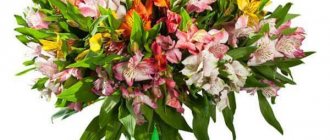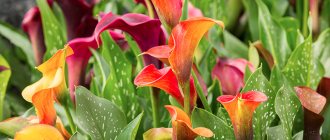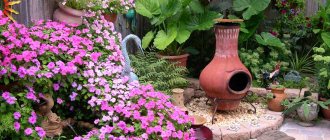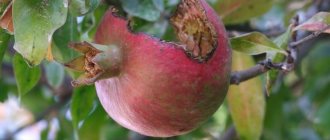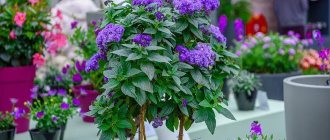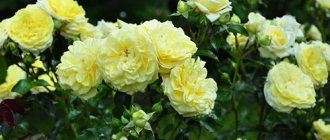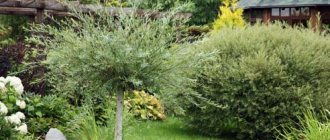Among flowering plants, tuberous begonia is popular. If you properly care for this plant, it will bloom profusely with beautiful double flowers that resemble roses.
The flower looks original in hanging vases, pots and containers on the balcony. In the summer it is planted in open ground, but it does not tolerate winter, so the tubers are dug up in the fall and stored at home until the next season.
Botanical description
Tuberous begonia is the collective name for natural species and complex hybrids grown in cultivation due to their beautiful corollas and long, abundant flowering. All of them have a fleshy underground tuber with adventitious roots and a pronounced dormant period.
Sometimes the culture is called bulbous begonia, which is incorrect. A tuber is a thickened modified shoot without a bottom and a protective shell, but with buds and eyes. The bulb is a plant in miniature:
- scales – modified leaves;
- bottom - shortened shoot;
- the rudiments of flower stalks are hidden in the center.
Begonias have a thick, round, fleshy stem. Among the tuberous varieties there are erect ones and those with flexible drooping shoots, reluctantly or well branched. Height usually ranges from 30 to 80 cm.
The leaves are round (Tuberhybrids), lanceolate (Bolivian), obliquely ovate (Big), but always asymmetrical, divided by the central vein into two unequal parts. The color of the plates in species plants is green, often reddish on the inside.
When breeding varieties or hybrids of tuberous begonia, little attention is paid to the leaves. But there are cultivars with whole vegetative organs, with faint denticles along the edge, or dissected. The color of the plates may contain bronze or burgundy shades.
Begonia flowers, including tuberous ones, are heterosexual:
- males are large, double or simple, some look like roses, carnations or camellias;
- female ones are small, always with one row of petals; hybrids have few or none at all.
The corollas are collected in brushes of several pieces. Most Turhybrids have 3-5:
- in the center there is a large male flower;
- on the sides there are small female ones.
Hybrids may not have fruiting buds. If they are present, in order for the begonia to become truly large-flowered, when caring for the crop, the female corollas are torn off.
Begonia sowing time
The choice of time for sowing begonia seeds depends on the desire: to wait for flowering in the same year or the next.
For example:
- When sowing seeds in January, by summer the tubers will grow, the plant will get stronger and the begonia will bloom in August. However, it must be remembered that additional lighting will be needed. For these purposes, use a fluorescent lamp.
- If you sow seeds in February and March, the plant will not have time to gain strength and will bloom only the next year. But there is no need for additional lighting; caring for seedlings is not so difficult.
Natural views
Even botanists find it difficult to answer how many species took part in the creation of the hybrid tuberous begonia, presumably 6-9. Some of them are worthy of attention and are grown in culture.
Previously, Russians and residents of neighboring countries could grow begonia from a tuber only by choosing planting material among hybrids. Now species plants and their varieties have appeared on the market.
Bolivian
Begonia boliviensis is distinguished by bell-shaped, fiery red corollas with elongated, pointed petals. Blooms in spring and summer, there are many varieties.
The plant is easy to care for, up to 30-80 cm. Drooping stems. The leaves are lanceolate, asymmetrical, with a long tip.
Bolivian tuberous begonia is best grown in hanging baskets like apmel.
Sutherland
Begonia sutherlandii is an easy-to-care species with drooping shoots. Forms a bush with a diameter of about a meter and a height of up to 0.5 m.
Sutherland
The corollas are small, with one row of petals, 1 cm in cross section, orange. Peduncles and petioles are reddish, leaves are dark and small.
Big
Begonia grandis - garden or indoor begonia. It looks less impressive than the previous two types, but is considered the easiest to care for among the tuberous ones.
Grows up to 60 cm. The leaves are greenish-olive, obliquely ovate, small, bulbs are formed in the axils, which are used for propagation. The flowers are pale pink and open in summer and autumn. Despite the drooping shoots, you can plant begonia as a tuber not only in a pot, grow it as an ampel, but also in flower beds.
Popular types and varieties
Tuberous begonia can be grown indoors and outdoors. All begonias are divided into subspecies, paying attention to the size of the flowers.
The following types are found:
- ampelous;
- small-flowered;
- medium-flowered;
- large-flowered;
- erect.
Erect tuberous begonias are grown at home and in open ground. One of the most popular representatives of upright houseplants is the Harlequin Picoti variety. It differs from other plants in its double yellow flowers with a red border. They are classified as medium-flowered and reach a diameter of up to 12 cm.
The ampelous home variety Chanson belongs to the small-flowered varieties of tuberous begonias. The diameter of the flowers is about 6 cm. They come in a variety of colors: white, yellow, red, orange. Flowers can be double or semi-double. The begonia hangs almost 45 cm from the hanging pot.
Popular flowers include the following varieties of begonia:
| Variety | Description |
| Golden ball | Large-flowered species, diameter can reach 20 cm. Grows well in open ground. |
| Kelblutrot | A plant with large red flowers. |
| Diva | It has unusual corrugated petals, painted in delicate colors: white, pink. |
| Marmorata | Attracts flower lovers with its delicate and lush appearance. The flowers are painted white, with red veins running through them like cobwebs, combined with a red stripe along the edge of the petals. |
| Picoti | The large flowers of the plant are colored yellow, white, and there is a pink stripe along the edge of the petals. |
| Margarita | This ampelous begonia blooms like a camellia. The flowers are medium in size and hang beautifully from hanging pots. |
Tubergybrids
Begonia x tuberhybrida is a common cultivated complex hybrid species of tuberous begonias. Has many varieties. Care is much more difficult than that of natural species. But this is the price to pay for high decorativeness.
Bushes 30-80 cm, leaves are large, up to 10-15 cm, green, reddish or bronze. Shoots are erect or drooping. Tuberous begonias branch reluctantly; to stimulate the appearance of lateral shoots, you need to pinch the top.
The size of the corollas depends on the variety, usually varying from 2-3.5 cm to 8-10. Some large-flowered hybrids have a diameter of up to 18 cm, which makes them more difficult to care for.
Petals can be arranged in one (simple) or several (terry) rows. Coloring - the whole range of colors, except shades of blue, cyan, violet.
The tuber size of a mature begonia is 5-6 cm. There are 1-3 growth points, sometimes 5. The dormant period lasts about 3 months.
Selecting a container for sowing
The most suitable container for begonia is considered to be a wide pot, about 8-10 cm high. Considering that the root system develops not in depth, but in breadth, such a pot is good for ventilation and access to oxygen to the roots. The capacity changes as the plant grows and develops.
For a young plant that has only recently taken root from a cutting or leaf, the container should have a diameter of about 6 cm. After 6 months, after the begonia has taken root and grown, it is transplanted into a pot with a diameter of about 12 cm.
You should also pay attention to the size of the plant and its age. When the begonia turns 3 years old, it should be transplanted into a container wider than the previous one. A small begonia should not be immediately planted in a large pot. If there is too much soil, the roots may rot and the soil will not have time to dry out.
How to choose tubers
It is not always possible to grow a begonia from a store-bought tuber, even if everything is done correctly. They may deteriorate during storage, or may initially be of poor quality.
Planting material in retail chains is usually sold in transparent packaging. When purchasing tubers individually at an exhibition, you can also get a good look at them. The surface should not be heavily wrinkled; any spots, spots, damage, especially obvious rot, are unacceptable.
It is important that the begonia tuber has a diameter of at least 3 cm.
Sometimes they sell planting material 2 or a little more than a centimeter from hand. But with good care and active phosphorus-potassium fertilizing, the nodule can reach this size in the first season. The owners do not leave the leafy plant to overwinter; they cut off the above-ground part and put it on sale. In spring, such a tuber may not wake up, or the bush will be very weak.
What affects germination?
In order for begonia seeds to sprout together, it is necessary to create favorable conditions. These include maintaining optimal temperature and maintaining soil moisture.
It is necessary to wait a maximum of about 3 weeks for seed germination. If they do not sprout, you will need to sow them again. We must remember that it is not easy to germinate begonia seeds. It has been observed that the germination rate is generally around 50%.
Reproduction
The easiest way to propagate Begonia grandis is to get new plants by simply planting the bulbs that have grown in the leaf axils.
Any tuberous begonia can be propagated vegetatively. The seed method is suitable for species plants, but not all cultivars. It is useless to collect your own planting material; only seeds from the store will provide varietal matching.
Cuttings of tuberous begonia
In addition to leaves, vegetative propagation shows good results. Rooting of plates is carried out only in Tubergybrids. Species and their cultivars also produce offspring from leaf cuttings. But due to its small size, the planting material may rot or dry out before it takes root.
Reproduction methods:
- tips of shoots 5-7 cm long;
- side branches broken out by hand from the leaf axils;
- plates from the middle tier;
- “extra” shoots growing from the tuber - they are twisted out by plunging your fingers into the substrate.
It is better to cut begonia in spring or early summer. Root:
- in water;
- perlite;
- peat, sand;
- light substrate mixed with baking powder.
Tuber division
When sprouts appear after a dormant period, an old tuber with a diameter of 5-6 cm is cut into pieces with a sterile knife or blade. Each must have at least one growth point.
Cover the wounds with brilliant green and dry for a day. Plant so that the shoot and 1/3 of the tuber are above the soil surface. The grown stems are sprinkled 2-3 cm deep.
Seed method
Begonias are sown in February or March. If the operation is carried out later, flowers will appear by the end of summer.
Sowing is done using a peat-sand mixture moistened with warm water, covered with glass, kept at 22-26 ° C and high humidity. Seeds sprout in the light.
Seedlings are planted at the stage of 2-3 true leaves. After picking, reduce the temperature to 18-21° C. Provide good lighting without direct rays, moderate watering, and protection from drafts.
What to do with tuberous begonia in the fall?
In autumn, initial frosts do not harm the tubers, so tuberous begonia is dug up after the leaves have fallen. A significant increase in tubers occurs at the end of the growing season due to the accumulated supply of nutrients and the establishment of renewal points.
In the house, the potted plant will bloom almost until the end of autumn. In October, the intensity of watering is reduced. After flowering is completed, the shoots are cut off and the tubers remain in dry soil or sand at a temperature of 8-10°C. In March - April they are transplanted into fresh soil mixture and watered regularly. When sprouts appear, the pots are placed in the light. If a large number of shoots are formed, they are partially used for cuttings, leaving 1-2 of the best shoots.
Planting in open ground
Even if the crop is grown outside, you first need to plant tuberous begonia in a pot, or a peat one. It will grow in the house and receive the same care as an indoor flower before moving to the flowerbed.
Deadlines
Planting times depend on the region. The operation is carried out no earlier than the soil warms up to 15 ° C; the air should have the same temperature at night.
In the central zone, tuberous begonia is planted in June; in the south, May planting is possible.
Be sure to prepare covering material for the first time. When it gets cold, the flower garden is covered with film, thin white spunbond or agrofibre, after driving pegs into the ground for support. Cellophane or non-woven material should not be placed on the flowers.
Selecting a location
Partial shade is suitable for planting tuberous begonias in any region. In the south, they try to hide the crop from the sun; direct rays are allowed in the morning or evening. Some varieties can grow there even in the shade, but they bloom worse.
In cool climates, on the contrary, well-lit areas are chosen for tuberous begonias. Due to the low sun activity, heat stroke or leaf burn rarely occurs, but it is still better to cover the bushes from direct midday rays.
In a sunny flowerbed, tuberous begonia can be planted under the protection of taller plants.
Bushes should not be placed in a wet or windy area, next to crops whose roots spread outwards.
Soil preparation
The soil should be light, loose, and not stick together after rain - black soil and loam are not suitable, even if intensive care is expected. The reaction of the substrate is close to neutral. You need to dig larger holes, fill them with a mixture of peat, sand, leaf humus and good garden soil.
If you fill the soil with fertilizers, you will have to fertilize less often.
It is recommended to water the flower garden with Fitosporin before or after planting. This will protect the plants from fungal diseases and eliminate preventive treatments from care.
How to plant tubers
Tuberous varieties of begonias in open ground must be well ventilated. The crop is prone to rot and fungal diseases, and crowded plants contribute to their spread.
Distance between holes:
- for tall varieties – 35-40 cm;
- medium – 25-30 cm;
- low, such as the Go-Go series - 15-20 cm.
Tuberous begonia, planting:
- Remove seedlings from containers. Peat pots are not touched.
- Dig into the prepared hole so that the roots do not bend and the shoots are at the same level as in the seedling containers.
- Water with Fitosporin solution if the soil has not been treated before.
- Mulch with peat, sand, completely rotted humus or treated pine bark. This makes maintenance easier - it retains moisture, prevents weeds from sprouting, and eliminates loosening. It also protects the roots from overheating or hypothermia.
Main varieties of begonia
There are many types and varieties of tuberous begonias.
They can be divided according to their features:
| Type | Description | Leaves | Flowers Bloom |
| Everblooming | Herbaceous perennial with a height of up to 36 cm depending on the variety. In the summer they are planted in the garden, in the winter they are placed at home. | Round green or burgundy. | White, yellow, pink, coral. Terry or simple. Most of the year. |
| Coral | Height - slightly less than 1 m. Unpretentious in home care. | Elongated, jagged. They are distinguished by matte finish and light speckles. | Red shades. Collected in inflorescences resembling corals. Early spring - first frosts. |
| Deciduous | Decorative indoor plant with drooping stems. Very capricious. Not grown outdoors. | Unusual colors: various contrasting patterns, spots, silver and pearlescent tints. | Small nondescript ones. Often absent. |
| Type | Varieties | Flowers |
| Erect | Dark Red | Large, dark red, like a rose. |
| Double yellow | Large yellow double ones. | |
| Party Dress | Reminiscent of the original huge carnations on a small bush. | |
| Camellia | Camel-shaped. | |
| Camellia Flora | Peony-shaped, waxy, pale pink with a snow-white border. | |
| Crispa White-red | They look like a large carnation, white with a burgundy or scarlet border. | |
| Picoti Lace Apricot | Terry, corrugated, apricot color, very large. | |
| Samba | Pastel colors of various shades, reminiscent of carnations. | |
| Ampelous | Chanson | Medium, semi-double or double, two-tone, camellia-like, in a variety of colors. |
| Christie | White terry. | |
| Sutherland | Small, simple sunny shades. | |
| Pikoti Cascade | Peony-shaped. |
Growing in the garden
Care in open ground has its own characteristics, although the requirements of tuberous begonias remain unchanged both at home and in open ground:
- high humidity;
- careful watering;
- regular feeding;
- protection from drafts;
- preventing water from entering vegetative organs.
You can plant tuberous begonia in a pot or hanging basket and take it outside.
Watering
Care in the open ground requires very careful irrigation, which is not easy to do in a flowerbed. If there is no drip irrigation on the site, you will have to abandon the cultivation of tuberous begonia - water must not get on the leaves or corollas. Unless there will be several bushes growing in the flower garden, which can be watered by hand, and when irrigating the remaining crops, covered, for example, with buckets.
Some gardeners place a hose between the plants and turn on a low pressure. This is a way out, but not the best - tuberous begonias are very fragile and easily break when laying a tube or from a careless touch of the owners.
The soil should dry out a few centimeters between waterings.
When it rains, it is advisable to cover the flowerbed with cellophane or tarpaulin. A wet flower will most likely rot, a large double flower will become heavy and may break the bush. Some gardeners buy or make special carriers for such crops themselves.
Feeding
If fertilizers are added to the soil during planting, when caring for tuberous begonias, fertilizing is applied no more than once a month. In other cases - every 2-3 weeks.
In the first half of the growing season, it is better to take specialized preparations for flowering garden plants, the list of which includes begonia.
Starting from mid-late July, if the bushes are going to be preserved until next spring, use nitrogen-free fertilizers - potassium monophosphate or Pekacid. When the begonia goes to the compost heap anyway, the fertilizers are not changed.
Wintering
Even in the southernmost regions, tuberous begonias do not overwinter in flower beds. They need to be dug up before the first frost with a lump of earth. It is better to carry out the operation when the temperature at night does not drop below 4°C.
Some gardeners recommend digging up begonia after the thermometer crosses the zero mark. But if the variety is valuable, it is better not to take risks.
They pick off flowers and buds when they are present. Leave the bush to dry in a warm, well-ventilated, dry room, along with the leaves and soil adhering to the tubers. When the stems die naturally, cut them off, leaving a 2 cm column, and send them to rest:
- contain in peat, sand or sawdust;
- in a dry place;
- at a temperature of 7-9° C (permissible range – 5-15° C);
- without light;
- lightly moisten the substrate once a month.
Use in landscape design
Upright plants are planted in above-ground containers or flower beds. They look great against the background of a decorative “wall”, in a white plastic flowerpot with a back wall, against a background of gray crushed stone or painted pebbles.
The beauty of blooming tuberous begonia will not leave anyone indifferent; it will improve the mood of every person. It is necessary to care for the plant carefully and painstakingly, but in gratitude you will receive beautiful flowering bushes. If you wish, you can arrange a magnificent flowering garden on your windowsill.
Planting and care at home
Growing tuberous begonia indoors is preferable. There the bushes are not exposed to negative weather factors, it is easier to arrange watering, control lighting and temperature.
If desired, flowers can be taken outside directly in pots or hanging baskets.
Germination and planting of tuberous begonia at home
At the end of February or beginning of March, the tubers are removed from storage. They can wake up earlier, on their own. If the begonia has rested for 3 months, you can immediately begin germination.
First, the tubers are inspected, if necessary, they are cleaned of rot or divided, the wound is disinfected and dried. They expose it directly in sawdust or sand to the light, raise the temperature - regular room temperature will do. Begin to water, wetting the substrate.
When the sprouts become clearly visible, place in a wide, low pot with bottom holes:
- Lay drainage.
- Fill the substrate, not reaching about 5 cm to the edge.
- Plant the tuber in the ground so that a third rises above the surface.
- Water with Fitosporin solution.
- When the shoots reach a height of about 5 cm, add soil, covering 2-3 cm of the stem.
You don’t have to germinate the tuber if the owners are confident in the quality. But not everyone knows which side to plant: the convex side should face down, and the notched side should face up.
Home care
The main thing is not to overwater the tuberous begonia - this will lead to rotting of the underground part and the base of the shoot.
The remaining content rules also require strict implementation:
- The lighting is bright, but without direct rays. Almost all varieties and hybrids feel great in light partial shade.
- Ideally the temperature is 18-21° C. Acceptable is from 15 to 25° C.
- Watering is regular, without stagnation of water in the pot. Between irrigations, the top layer of soil should dry out.
- The humidity is high, but in order to prevent the leaves from rotting, the bushes cannot be sprayed. Bowls with water are placed next to the pots, wet expanded clay, sphagnum, and pebbles are placed in the tray. Buying a household humidifier will save you from problems.
- Feeding - from spring to mid-summer with specialized mineral fertilizers every 2 weeks. Starting from the second half of August, only potassium and phosphorus should remain in the diet of tuberous begonia.
- Young bushes are transplanted 3-4 times a year. An adult tuber is planted in the spring and is not touched unless necessary until the end of the growing season.
- The soil is light, loose, neutral. Ready-made soils “Begonia” or “Violet” are suitable.
Rest period
At the end of the season, gradually reduce watering, stop feeding, and place the pot in the shade. When the above-ground part dries out on its own, it is cut to 2 cm. The tuber is left in the pot or dug up and placed in peat, sand or sawdust. You can store planting material in a frost-free basement or vegetable section of the refrigerator. As a last resort - under the bathroom.
How to care for tuberous begonia during the dormant period and storage conditions are described in the “Wintering” chapter of the section devoted to maintaining the crop in open ground.
First-year plants grown from seeds or through vegetative propagation spend the rest period leafy on the windowsill. Care is the same as always, only stop feeding and water less often.
Transplantation to a permanent place
Often, a young plant that has just grown from seeds or leaves has to be transplanted to a permanent place of growth. Sometimes a cutting that has already rooted well is replanted.
For good rooting of the plant, it is recommended to follow the following rules:
- Take a prepared pot, preferably short but wide in diameter.
- Place a drainage layer in the form of pebbles, expanded clay, or broken bricks at the bottom.
- Sprinkle a little charcoal as a protection against waterlogging, about 1 cm.
- Fill the pot halfway with substrate.
- Remove the plant from another pot. If this is difficult to do, in order not to damage it, wet the soil well or place the pot in a basin of water.
- Remove some of the old substrate from the roots and place the plant in the center of another pot.
- Fill the pot with soil, leaving about 1.5 cm on top.
- Be sure to water the plant. If the soil settles a little, it is advisable to fill it up.
- Considering that the root system is damaged during replanting, in order for the adaptation process to go faster, it is necessary to water the soil with Kornevin or succinic acid. The product can be purchased at a pharmacy.
- During the first days, shade the flower from the sun.
Problems during cultivation
Most often, the troubles of tuberous begonia are associated with waterlogging of the soil or water getting on the stems or leaves - the plant begins to rot. Indoor diseases include botrytis, brown spot and powdery mildew. In open ground, the crop is affected by a wide range of fungal infections. Therefore, it is necessary to water the planting with Fitosporin.
At home, tuberous begonia suffers from:
- from mealybugs;
- scale insects;
- nematodes;
- spider mites;
- thrips.
For open ground, the first two pests are rare. But added to the list:
- slugs;
- snails;
- aphids;
- whiteflies.
When growing tuberous begonias, care-related problems may arise:
- light spots appear from direct sunlight;
- the edges of the leaves turn brown and dry out from water with chlorine;
- growth slows down, there are no buds due to nutritional deficiency;
- excess nitrogen leads to an increase in green mass to the detriment of flowering;
- due to insufficient watering and dry air, the leaves curl, the tips dry out, and the buds fall off;
- in an open flowerbed, the wind can break the stems;
- In the ground, double flowers rot after rain.
Site Expert:
Galina Alexandrovna
More than 30 years of experience in growing indoor and garden flowers
Ask a Question
Caring for tuberous begonias cannot be called simple. But if you choose the right substrate and pot, in the open ground - a planting site, follow agricultural technology, even novice gardeners should not have any special problems. Close attention should be paid to watering.
What does the plant suffer from and methods of treatment
Tuberous begonia is a rather unpretentious plant, but if you do not follow the rules for its care, you may encounter the following problems:
- Curled leaves that have dried at the edges
may be a result of sunburn or high temperature; you need to move the begonia to a cool place. But if the leaves begin to fall off, it means the plant is cold. - Dull leaves covered with a thin web
are symptoms of the appearance of spider mites; to get rid of them, the begonia needs to be sprayed with any insecticide and take care of the correct level of humidity - at least 60%. - The appearance of rot both on the stem and on the leaves of begonia
is gray rot, which affects the plant due to excessive watering and stagnation of moisture, as well as regular contact with drops of water on the surface of the crown. In order to get rid of this, you need to review the plant’s watering regime - let the soil dry out after the previous watering, and treat the affected areas with crushed sulfur or a solution of colloidal sulfur. - Plaque on the leaves:
greenish-brown is another symptom of gray rot, white powdery is powdery mildew. In order to cure the plant, you need to treat it with a fungicide and move the begonia to a well-ventilated place. - The most dangerous diseases are very difficult to fight, so if begonia is affected by them, then in order not to infect other plants, it must be thrown away. These are root-knot nematodes and soft scale insects, which have very similar symptoms - growths and swellings on the stems
.
A mild fungicide that can be used frequently for preventative purposes is 1 tablespoon of baking soda per 3 liters of water.
Tuberous begonia - planting and care.
Features and differences between wintering home and garden begonias
November is the beginning of the rest period, but this is an approximate period. It all depends on where the plant spent the summer. What is the goal, to extend flowering or reduce it. But in any case, the flower needs to rest for at least 3 months.
Indoor
When storing domestic plants in winter, they are not removed from the pot, but cut off, leaving a shoot of 1 cm. They are kept under the conditions described in the seasonal table.
Garden
At the end of October, garden specimens are dug up, the roots are shortened, treated with a fungicide (Fitosporin), dried, and placed in a container with peat. Place in a dark, dry room until spring. They can also be stored on the refrigerator door, wrapped in sphagnum moss or in a cotton bag.
In the spring, they are planted in a pot, and after germination, they are planted in open ground.
Begonia stem garter, photo
One of the plant care measures is staking the begonia stem; a photo of the correct support is presented below.
As a rule, indoor begonias are mostly low-growing. Tuberous flowers are much larger and require staking. With proper support, the stems will not break and the flower will delight its owners with abundant flowering and the beauty of the leaves for a long time.
How to plant a plant
In our climatic conditions, tuberous begonia can only be grown as annual plants.
In the summer, rhizome species of the flower are grown in a flower garden, and in the winter they are dug up, transplanted into a container, and brought into a warm room.
The most common method is to grow in pots, which can be moved from the garden to the house when bad weather occurs. Sometimes there are no visible reasons for concern, but constant movement can lead to the formation of more regular flowers than double ones. This is precisely the reason that before planting begonias, you should carefully choose the location, as well as the most suitable variety for you.
The site should be located in partial shade, where there will be no drafts. In our climate, rhizomatous ever-flowering species, as well as tuberous begonias, can grow without much difficulty. Other species will also be able to grow on closed loggias or verandas.
How to replant a flowering begonia from a store
First of all, you should remember that you need to replant a houseplant only when it no longer fits in its container and the roots extend beyond.
- According to the rules, this procedure is carried out no earlier than March and no later than May.
- Carefully remove from the container.
- We clean the roots from the remnants of old soil.
- Place in a weak manganese solution for 15-20 minutes.
- We remove all damaged and diseased roots, sprinkle all cut areas with crushed coal.
How to prepare begonia for winter
With the onset of autumn, tuberous begonia stops blooming and growing. Over time, the foliage begins to die and the shoots dry out. At this moment, the tuber begins to receive all the beneficial substances, which allows it to strengthen and grow.
As soon as cold weather sets in, dried shoots should be cut off and watering of the plant should be reduced.
If the flower grew in the garden, then with the onset of cold weather you should not immediately start digging up its tubers. Of course, as already mentioned, begonia loves warmth very much, but before digging up its bulbs you should wait until all the shoots and leaves die off and the beneficial substances pass quietly to the tubers. During this period, new growth points begin to form on them.
Young plants with small bulbs should overwinter in pots on well-lit windowsills. Under such conditions, the foliage and stems do not die off, but the growth and flowering of begonias stops. The air temperature in the room where the flower will winter should not be below +15 degrees. The plant is watered quite rarely.
Adult bulbs are stored in cool places. If the plant grew in a pot, then the bulb can be left to winter in it. If the tuber was dug out of the ground, then it should be placed in a box filled with sand or peat. Be sure to moisten the substrate in which the tubers are stored so that they do not dry out. The period in which the bulbs are dormant begins in November and lasts until February.
What tubers should you buy for growing begonias?
If you dream of growing a beautiful, lushly flowering begonia, then you should choose bulbs not in supermarkets, but in stores specializing in various plants.
The most suitable time to purchase tubers is February, since at this time they begin to arrive in stores from Holland. Do not focus on the label, because the most important thing in the choice is the planting material. In addition, under no circumstances wait until prices for a given product begin to decline, as this will indicate that the product is of poor quality, which means that you may not wait for the long-awaited flowers.
Your choice should be on a hard, not overdried tuber, which has no traces of mold or plaque. Often there may be more than 2 tubers in one package; be sure to inspect everything contained in the package. If you notice that one of the planting materials is of poor quality, you should put this packaging aside and look for larger bulbs. Give preference to those specimens that already have awakened buds.
We display the final result:
- High-quality and “correct” tubers will always be plump to the touch without bruises, brown in color, and not have suspicious spots;
- If the period is already suitable: the end of February or the beginning of March, growing buds should be present on the nodules;
- You should not rush at the emerging stem shoot, these are already overgrown tubers, and the shoot may be injured during planting.
Diseases and pests
Tuberous begonia is considered a strong plant and resistant to most diseases, but the owner will still have to remember something.
- Most often, tuberous begonia (and other varieties) are affected by mold. The cause may be an infection, but mainly this trouble occurs due to non-compliance with the level of humidity in the room. When gray, slightly damp spots appear on the leaves, think about whether you ventilate the room often enough and whether you are watering your pet too much? By the way, mold is dangerous not only for home greenery, but also for people living in the apartment.
- Powdery mildew is another consequence of high humidity and too generous watering. A whitish powdery coating appears on the ground part of the flower, which cannot be scraped off with a finger, and only a fungicide, “Benomil” or something similar, will help get rid of it.
- Gray rot, like powdery mildew, affects leaves and stems, but the coating is not white, but gray. The plant must be urgently moved to a drier and cooler place and treated with a fungicide.
- Black rot appears on the root system and, unfortunately, is most often discovered late, when the affected area is large and nothing can be done (during replanting, for example). If the disease has just begun, cut off the damaged roots, treat with a fungicide and replant the plant in fresh soil.
- The red spider mite appears in a warm and humid atmosphere: the leaves become marbled in color, then turn yellow and fall off, the stems become entangled in cobwebs. And all this happens in a very short period of time. The drug "Decis" will help to cope with insects: the plant is sprayed with it several times, paying special attention to the back side of the leaves - mites settle there.
- The whitefly feeds on cell sap, biting through the leaves, which is why the plant stops growing, turns yellow and withers. Try spraying the begonia with a solution of soap (dilute 40 g of laundry or tar in 10 liters of heated water), making sure that the solution does not get on the roots. If the recipe doesn’t help, buy Fitoverm or Actellik.
- The nematode is the most dangerous of all pests. First of all, because it is not visible, since it settles in the ground and practically does not come to the surface. When the owner notices that the roots of the flower become thick, grape-shaped, and full of larvae, not a single insecticide will help save the plant. The only thing you can do is carry out the propagation procedure and grow a new specimen.
The procedure for treating plants with chemicals and other preparations to get rid of insects requires compliance with a number of conditions. First, don't allow children, pet dogs, or cats to hang around. Secondly, arrange ventilation after work. And thirdly, do not neglect gloves, goggles and a pharmaceutical mask to protect your respiratory organs, eyes and skin.
What other difficulties may arise when growing tuberous begonia?
- If the begonia's buds suddenly fall off during the budding period, it means that you disturbed it at this time: either you moved the pot to another place, watered it incorrectly, or stopped feeding it.
- Yellow leaves indicate soil depletion, lack of water, or the appearance of a dangerous pest.
- Why doesn't it bloom? The reasons may be different: soil depletion, lack of light or water, drafts, incorrectly chosen fertilizers, pests. All you have to do is analyze your actions and adjust your care.
The active life span of tuberous begonia is only 5-6 years. If the plant has exhausted its resource, nothing will help.
